Olga Krestinskaya
Towards Efficient IMC Accelerator Design Through Joint Hardware-Workload Co-optimization
Oct 22, 2024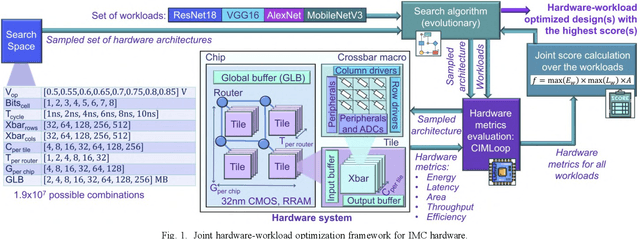

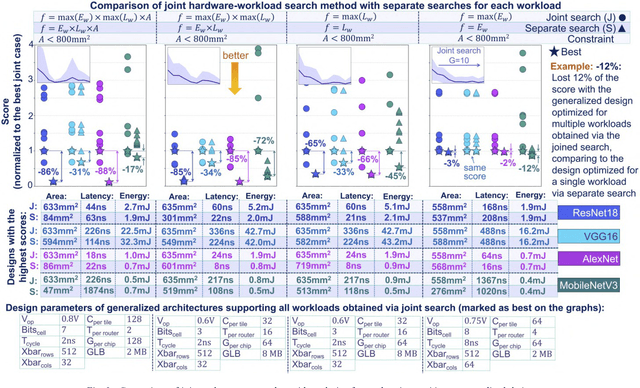
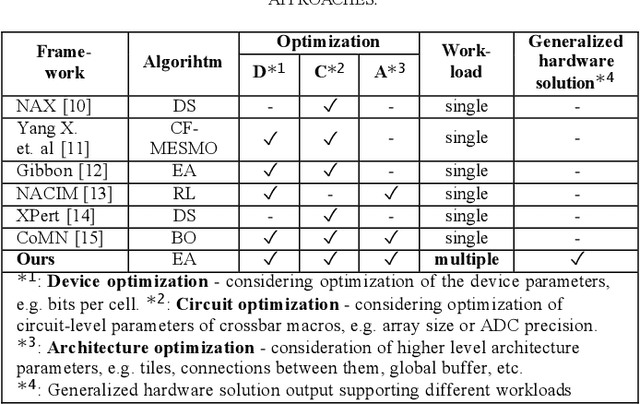
Abstract:Designing generalized in-memory computing (IMC) hardware that efficiently supports a variety of workloads requires extensive design space exploration, which is infeasible to perform manually. Optimizing hardware individually for each workload or solely for the largest workload often fails to yield the most efficient generalized solutions. To address this, we propose a joint hardware-workload optimization framework that identifies optimised IMC chip architecture parameters, enabling more efficient, workload-flexible hardware. We show that joint optimization achieves 36%, 36%, 20%, and 69% better energy-latency-area scores for VGG16, ResNet18, AlexNet, and MobileNetV3, respectively, compared to the separate architecture parameters search optimizing for a single largest workload. Additionally, we quantify the performance trade-offs and losses of the resulting generalized IMC hardware compared to workload-specific IMC designs.
Towards Efficient In-memory Computing Hardware for Quantized Neural Networks: State-of-the-art, Open Challenges and Perspectives
Jul 08, 2023Abstract:The amount of data processed in the cloud, the development of Internet-of-Things (IoT) applications, and growing data privacy concerns force the transition from cloud-based to edge-based processing. Limited energy and computational resources on edge push the transition from traditional von Neumann architectures to In-memory Computing (IMC), especially for machine learning and neural network applications. Network compression techniques are applied to implement a neural network on limited hardware resources. Quantization is one of the most efficient network compression techniques allowing to reduce the memory footprint, latency, and energy consumption. This paper provides a comprehensive review of IMC-based Quantized Neural Networks (QNN) and links software-based quantization approaches to IMC hardware implementation. Moreover, open challenges, QNN design requirements, recommendations, and perspectives along with an IMC-based QNN hardware roadmap are provided.
Variation-aware Binarized Memristive Networks
Oct 14, 2019



Abstract:The quantization of weights to binary states in Deep Neural Networks (DNNs) can replace resource-hungry multiply accumulate operations with simple accumulations. Such Binarized Neural Networks (BNNs) exhibit greatly reduced resource and power requirements. In addition, memristors have been shown as promising synaptic weight elements in DNNs. In this paper, we propose and simulate novel Binarized Memristive Convolutional Neural Network (BMCNN) architectures employing hybrid weight and parameter representations. We train the proposed architectures offline and then map the trained parameters to our binarized memristive devices for inference. To take into account the variations in memristive devices, and to study their effect on the performance, we introduce variations in $R_{ON}$ and $R_{OFF}$. Moreover, we introduce means to mitigate the adverse effect of memristive variations in our proposed networks. Finally, we benchmark our BMCNNs and variation-aware BMCNNs using the MNIST dataset.
* 4 pages, 3 figures, 3 tables
Wafer Quality Inspection using Memristive LSTM, ANN, DNN and HTM
Sep 27, 2018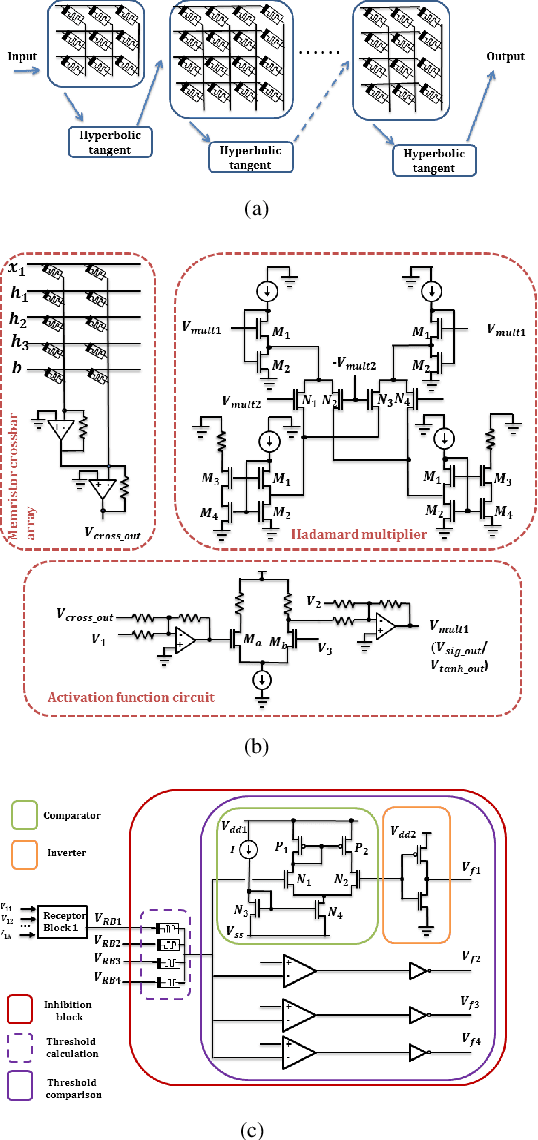
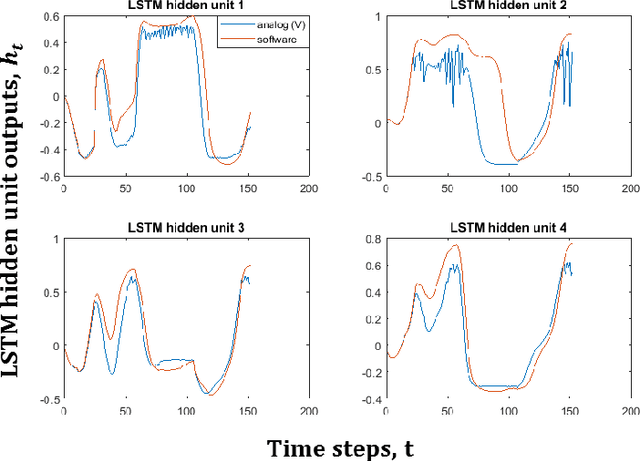
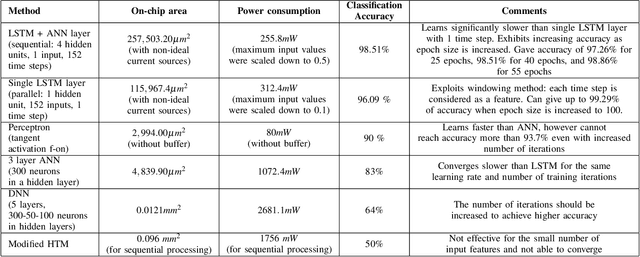
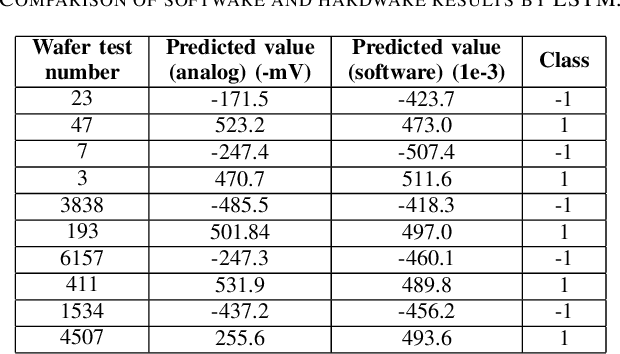
Abstract:The automated wafer inspection and quality control is a complex and time-consuming task, which can speed up using neuromorphic memristive architectures, as a separate inspection device or integrating directly into sensors. This paper presents the performance analysis and comparison of different neuromorphic architectures for patterned wafer quality inspection and classification. The application of non-volatile memristive devices in these architectures ensures low power consumption, small on-chip area scalability. We demonstrate that Long-Short Term Memory (LSTM) outperforms other architectures for the same number of training iterations, and has relatively low on-chip area and power consumption.
Learning in Memristive Neural Network Architectures using Analog Backpropagation Circuits
Aug 31, 2018

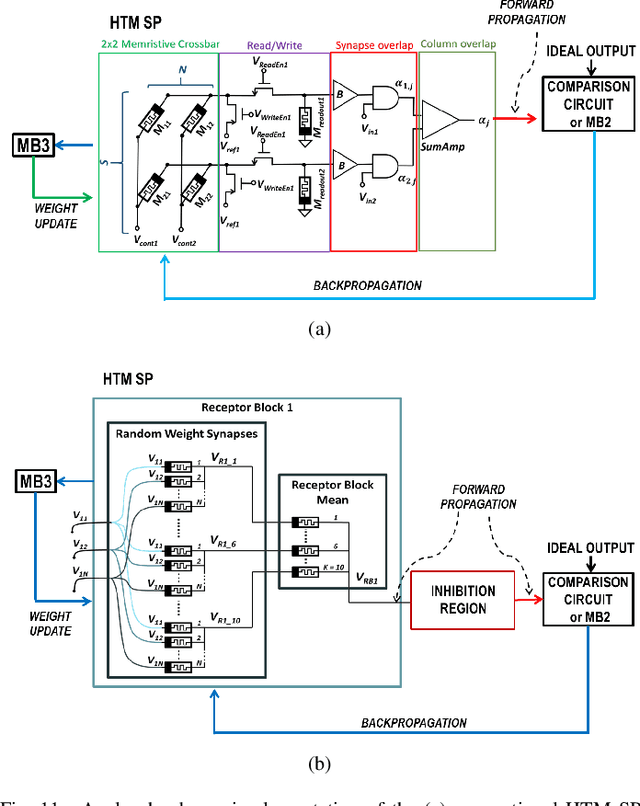

Abstract:The on-chip implementation of learning algorithms would speed-up the training of neural networks in crossbar arrays. The circuit level design and implementation of backpropagation algorithm using gradient descent operation for neural network architectures is an open problem. In this paper, we proposed the analog backpropagation learning circuits for various memristive learning architectures, such as Deep Neural Network (DNN), Binary Neural Network (BNN), Multiple Neural Network (MNN), Hierarchical Temporal Memory (HTM) and Long-Short Term Memory (LSTM). The circuit design and verification is done using TSMC 180nm CMOS process models, and TiO2 based memristor models. The application level validations of the system are done using XOR problem, MNIST character and Yale face image databases
Binary Weighted Memristive Analog Deep Neural Network for Near-Sensor Edge Processing
Aug 02, 2018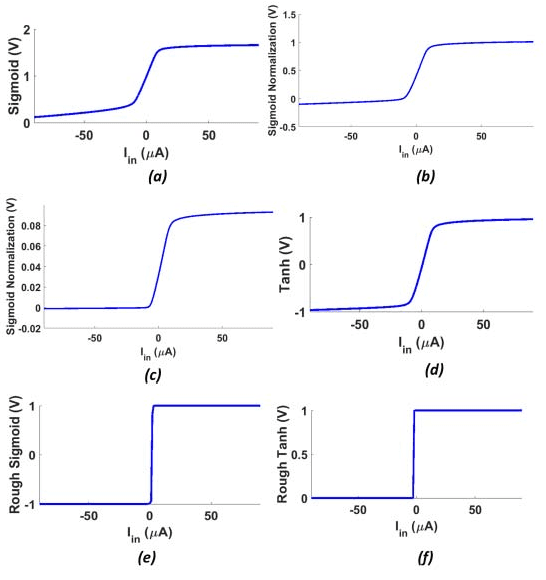
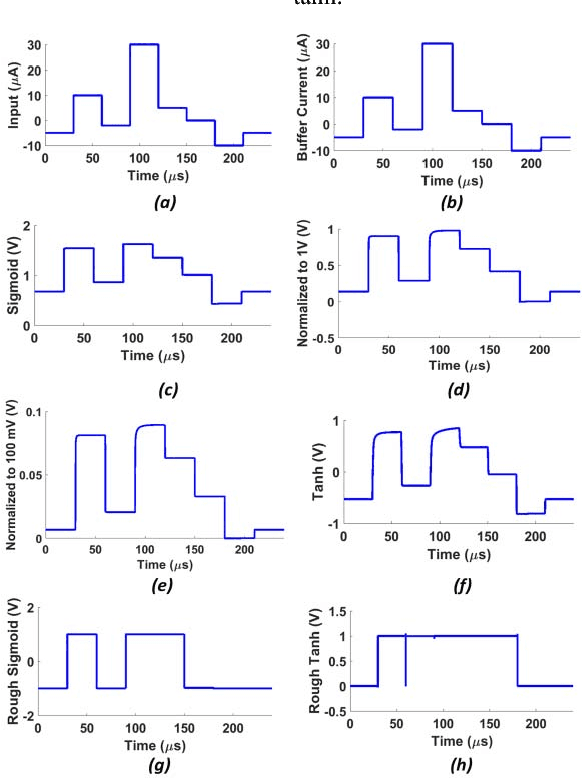
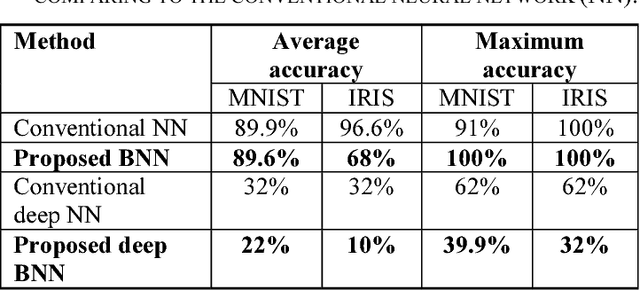
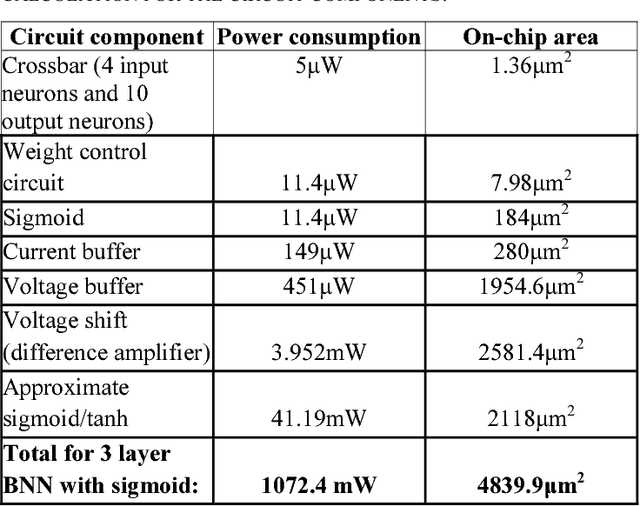
Abstract:The memristive crossbar aims to implement analog weighted neural network, however, the realistic implementation of such crossbar arrays is not possible due to limited switching states of memristive devices. In this work, we propose the design of an analog deep neural network with binary weight update through backpropagation algorithm using binary state memristive devices. We show that such networks can be successfully used for image processing task and has the advantage of lower power consumption and small on-chip area in comparison with digital counterparts. The proposed network was benchmarked for MNIST handwritten digits recognition achieving an accuracy of approximately 90%.
Approximate Probabilistic Neural Networks with Gated Threshold Logic
Aug 02, 2018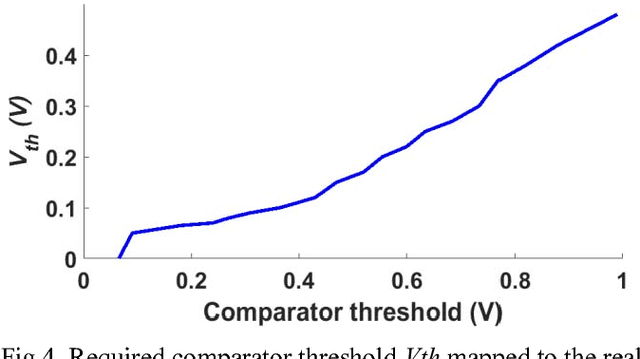
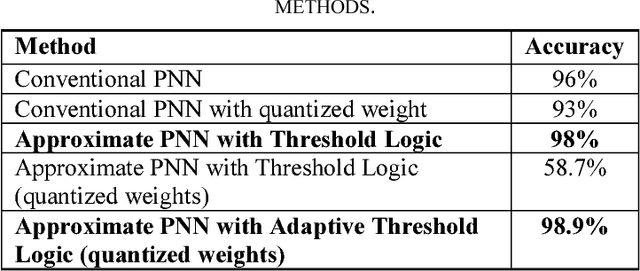

Abstract:Probabilistic Neural Network (PNN) is a feed-forward artificial neural network developed for solving classification problems. This paper proposes a hardware implementation of an approximated PNN (APNN) algorithm in which the conventional exponential function of the PNN is replaced with gated threshold logic. The weights of the PNN are approximated using a memristive crossbar architecture. In particular, the proposed algorithm performs normalization of the training weights, and quantization into 16 levels which significantly reduces the complexity of the circuit.
Neuro-memristive Circuits for Edge Computing: A review
Jul 01, 2018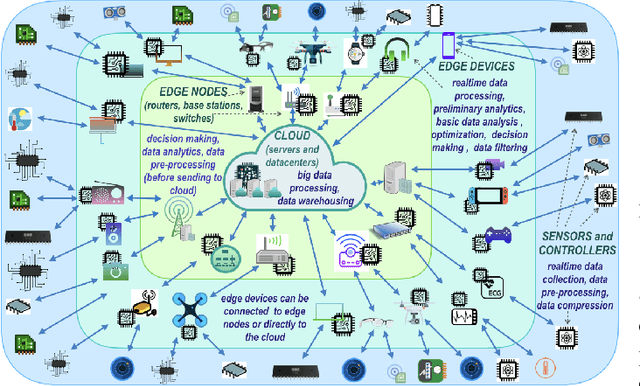

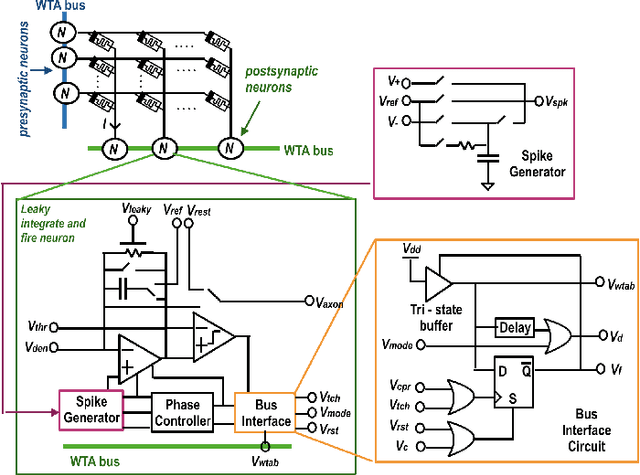
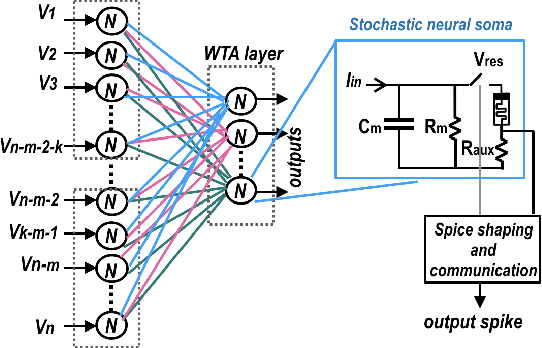
Abstract:The volume, veracity, variability and velocity of data produced from the ever increasing network of sensors connected to Internet pose challenges for power management, scalability and sustainability of cloud computing infrastructure. Increasing the data processing capability of edge computing devices at lower power requirements can reduce the overheads for cloud computing solutions. This paper provides the review of neuromorphic CMOS-memristive architectures that can be integrated into edge computing devices. We discuss why the neuromorphic architectures are useful for edge devices and show the advantages, drawbacks and open problems in the field of memristive circuit and architectures in terms of edge computing perspective.
Feature extraction without learning in an analog Spatial Pooler memristive-CMOS circuit design of Hierarchical Temporal Memory
Mar 14, 2018



Abstract:Hierarchical Temporal Memory (HTM) is a neuromorphic algorithm that emulates sparsity, hierarchy and modularity resembling the working principles of neocortex. Feature encoding is an important step to create sparse binary patterns. This sparsity is introduced by the binary weights and random weight assignment in the initialization stage of the HTM. We propose the alternative deterministic method for the HTM initialization stage, which connects the HTM weights to the input data and preserves natural sparsity of the input information. Further, we introduce the hardware implementation of the deterministic approach and compare it to the traditional HTM and existing hardware implementation. We test the proposed approach on the face recognition problem and show that it outperforms the conventional HTM approach.
Facial emotion recognition using min-max similarity classifier
Jan 01, 2018



Abstract:Recognition of human emotions from the imaging templates is useful in a wide variety of human-computer interaction and intelligent systems applications. However, the automatic recognition of facial expressions using image template matching techniques suffer from the natural variability with facial features and recording conditions. In spite of the progress achieved in facial emotion recognition in recent years, the effective and computationally simple feature selection and classification technique for emotion recognition is still an open problem. In this paper, we propose an efficient and straightforward facial emotion recognition algorithm to reduce the problem of inter-class pixel mismatch during classification. The proposed method includes the application of pixel normalization to remove intensity offsets followed-up with a Min-Max metric in a nearest neighbor classifier that is capable of suppressing feature outliers. The results indicate an improvement of recognition performance from 92.85% to 98.57% for the proposed Min-Max classification method when tested on JAFFE database. The proposed emotion recognition technique outperforms the existing template matching methods.
 Add to Chrome
Add to Chrome Add to Firefox
Add to Firefox Add to Edge
Add to Edge